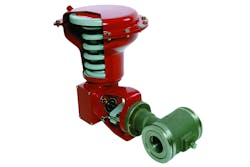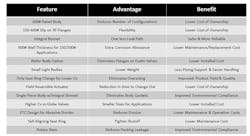Selecting the right control valve for your processing application
The control valve plays a considerable role in establishing and maintaining an efficient process. When selecting among the available options, be sure to evaluate how the control valve’s features match the application’s fluid requirements in terms of versatility, stable flow control, ability to handle a range of flows and connectivity for remote monitoring. Also look for characteristics that make it easier to maintain. Of the available options, rotary valves and linear angle valves offer widespread applicability.
Process control valve basics
Control valves alter fluid flow by varying the size of the flow passage as directed by a signal from a controller. This enables the direct control of flow rate and the consequential control of key process parameters, including pressure, temperature and liquid level.
Several major types of control valves are available; each has pros and cons and may be most appropriate for different applications. Finding the valve that works best for a specific application is a challenge. Key considerations regarding technical specification include the level of control offered, resolution achieved and the valve’s delivery time. Maintenance and longevity should also be considered. Several factors come into play during selection, including the need for application-specific knowledge and expertise, economic restrictions, plant outage schedules and maintenance plans over the life of the valve.
Options available
Linear globe valves are used for their versatility to regulate flow over a wide range, ability to mitigate noise and because they offer easier access to valve internals during maintenance. They typically consist of a disk or cylindrical plug element with a stationary ring seat in a generally spherical body. Globe valves include stem-guided, cage-guided and top- and bottom-guided varieties. Stem- and top/bottom-guided valves are better suited for general industrial and less-aggressive applications. Cage-guided valves tend to be more costly, but perform in a broader scope of applications and have more flexibility to incorporate noise or cavitation mitigating features. All varieties may be controlled by electrical, pneumatic, manual or hydraulic means of actuation.
Linear angle valves are similar to globe-style valves, but are better suited for the most severe applications with large flow rates, noise and flashing, since the mitigating technology can be more efficiently sized and integrated into the plant system. Stem-guided and cage-guided options are offered and actuation is typically pneumatic or hydraulic due to the high internal forces and rapid response necessary in these applications.
A linear three-way control valve has one inlet and two outlets or vice versa and is used in industrial applications. This enables mixing of liquids from two pipes into one pipe, or separating water from one pipe into two pipes. Typical applications include air-handling units, water chillers, boilers and fan coils. This option is usually offered in stem-guided and cage-guided options. It is typically not used for the most severe applications, but rather to control the amount of flow or pressure in one section of the piping system with respect to another.
Finally, rotary valves use the rotation of a passage or passages in a transverse plug to regulate the flow of liquid or gas. Rotary valves have a wide range of applicability, depending on the technology incorporated in the internals. Globe and even angle valves have a relatively torturous flow path, which requires more pressure drop to achieve a given flow, all other parameters being equal. A rotary valve can offer an inline, less torturous path, while still providing similar flow control, rangeability and resilience in severe-system conditions. Its layout provides inherent benefit in situations where the working fluid contains solids and cleanliness cannot be maintained. These conditions would have a severe impact on globe or angle valve performance.
Table 1 provides a general overview of the typical applications for which each control valve type is most suited. Rotary valves offer by far the most widespread applicability; linear angle valves are also appropriate for a wide range of applications.
Table 1. General overview of the typical applications for which each control valve type is most suited
Other factors affecting control valve selection
Industry and country standards, including American Society of Mechanical Engineers (ASME), Canadian Registration Number (CRN), Pressure Equipment Directive (PED) and American Petroleum Institute (API), among others, can affect the suitability of certain valve selections. In addition, selection of the control valve for an application is affected by varying customer expectations — end users, engineering-procurement-construction (EPC) contractors and installation contractors have varying priorities in selection criteria. Of these points of view, the most important is the end user, who wants a control valve that provides the required control with the highest ease of use and maintenance over the valve’s life.
Features to look for in a control valve
During the selection process, look for and evaluate how the options under consideration meet these key features:
- Versatility and ruggedness — Can the valve handle the full breadth of conditions between the minimum and maximum specified conditions? Is it robust enough to withstand upset conditions? Does it offer long service life without maintenance?
- Works equally well on clean, dirty, viscous, corrosive, abrasive, high pressure/temperature fluids liquids and gases — Standardization across the install base helps with maintenance requirements and spare parts inventory. Adding filtering and cleaning of the working fluid in a system is good practice, but it also increases maintenance of those filters, which must be considered in system design.
- Stable flow control — Consistent control in all conditions is critical. Inconsistency in control will lead to production downtime and loss of product.
- Meets appropriate linear, equal percentage or other control characteristics — Different process conditions require: different control characteristics. Know the characteristics required and evaluate and confirm the control valve meets them.
- Rangeability — Make sure the valve can handle all flow changes in the process.
- Connectivity to a building/process management system — Remote monitoring and control is critical to processing applications. Ensure the valve is compatible with the building/process management system.
Features to ensure proper control valve maintenance
In addition to selecting valves that meet the criteria discussed above, it is crucial the valves have features that ensure proper maintenance. Here are the key features to look for:
- Self-aligning seat ring for tight shutoff, no shimming or hardened materials
- Access to the packing for inspection and adjustment
- Splined or coupled shaft connections that allow ease of connect/disconnect from actuation
- Blowout-proof shaft protection
- Enclosed and self-purging actuator linkage
- Ability to work on the valve without having to remove the body from the system
- The valve’s ability to maintain tight shutoff to minimize loss of working fluid when it is not needed downstream of the valve. Keep in mind that control valves are not isolation valves, so do not use them in lieu of proper isolation valves for plant safety.
Rotary valve versatility
With a high range ability of 100-to-1 turndown, and a small footprint, rotary control valves offer a larger flow coefficient (Cv) than the standard globe style valve.
For example, Figure 1 shows a rotary valve used in a pulp and paper application that is designed to handle corrosive and erosive mediums and fiber at the same time. The geometry and operation of the stem-plug is such that it can operate under the harshest conditions, even shearing off material, while handling anything flowing through it, from sludge-like material to sand and small debris. Maintaining performance in this application with a globe valve will be much more difficult, and may require additional maintenance or compromise in other performance parameters.
The valve in Figure 1 uses an efficient straight-through flow design that allows for a much lower cost per Cv than conventional globe-style control valves. Large-shaft diameters machined of high-strength materials provide the torsional and flexural rigidity required under high operating pressures.
A globe-style valve would require additional pressure drop for a given flow condition, driving the valve size larger, and the difficult flow conditions can cause faster wear and tear of the internals.
Consider a rotary control valve
While many options work for specific applications, and globe or angle valves are highly versatile, a rotary control valve can improve on key application challenges that would otherwise result in oversizing the valve and increased maintenance. This allows for reduced plant costs and reduced stocking requirements. (See Table 2 for benefits and advantages of rotary plug control valves.)
Table 2. Benefits and advantages of rotary plug control valves
Julian Millares, P.E., is senior engineering manager at CIRCOR Industrial Valves Americas. Millares has worked in engineering roles for more than 20 years in markets and industries ranging from space and avionics to Navy, commercial marine and cryogenics. He is an active member of the American Society of Mechanical Engineers (ASME) and holds a Bachelor of Science from University of South Florida and a Master of Business Administration from the University of Florida.


